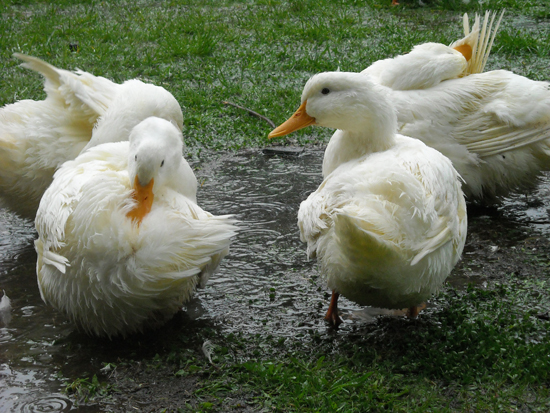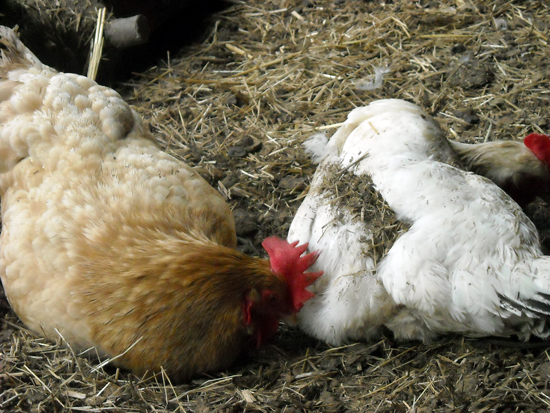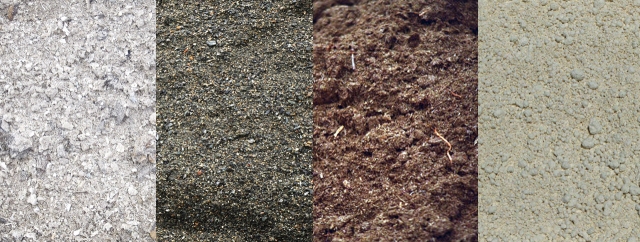[repost from my Cappers Farmer blog: http://www.cappersfarmer.com/blogs/falcos-poultry.aspx ]
We all enjoy a good bath, right? Well your birds are no different. They enjoy preening, bathing and cleaning themselves as well. It is an important natural behavior which keeps your birds healthy and happy.
Waterfowl

(Ducks Bathing)
Ducks, geese and other waterfowl bath similar to the way we bath, albeit a little messier; splashing around in water and causing a ruckus. They enjoy their daily bath and really do not keep as clean or healthy without this bath. Giving your waterfowl access to fresh, pooled water is an excellent measure to keeping your birds healthy.

(Chickens Taking a Dust Bath)
Chickens, Turkey and other Poultry
Chickens, turkey and other such birdies love to bath in dirt. When water penetrates and saturates these birds, it soaks their down and lowers their body temperature to a dangerous, possibly hypothermic level. Instead, they prefer to bath in dust. The best dust baths consist of four substances which stop the spread of fleas, mites and other nasties which can infest your flock.

(Wood Ash, Construction Sand, Peat Moss and Diatomaceous Earth)
Dust Bath
Provide your birds with a section of ground, covered from the rain, with a lovely dust bath comprised of one part wood ash, one part construction sand (different-sized grains of sand), one part peat moss and one part diatomaceous earth. Your birds will bath in this bath and will use it for grit all the while stopping fleas, mites, worms and parasites from taking over.
If you have an outbreak of nasties despite your best efforts (sometimes nature pulls ahead in this race), treat your birds with this easy DIY salve.
Poultry Mite and Flea Relief Salve
1 cup Coconut Oil
1/8 cup Beeswax (shavings)
3 tbsp Neem Oil
1 tbsp dried Plantain Leaf
Gently melt the beeswax, coconut oil and add the dried plantain leaf using low heat for 3 hours (a crock pot is handy for this). Add the pure Neem Oil, stir, stir, stir and once again stir then pour into small tins or glass jars.
Treatment: rub on bird’s legs, around vent or other infected areas. Be careful to get it into their eyes or other sensitive areas.
Warning: Neem oil is a very effective, natural insecticide. It will kill fleas, mites and other nasties. But be aware, it is also a spermicide. This means that fertility will diminish drastically for at least 10 days – 30 days after use around the vents of the birds.


We brought home three ducks after our Thanksgiving visit to our older son’s home. Tomorrow I’m butchering the Pekin. The other two (Black Swedish) need to fatten up a bit. Meanwhile, they’re living in our garden tub.
It’s actually worked out since it’s so easy to clean the tub and they are really enjoying their daily swims/baths when I fill the tub for them.
Now I just have to make sure my husband (city boy) doesn’t decide he wants them as pets rather than as dinners!
LikeLiked by 1 person
Hahahaha! Yes, every now and again a bird or two cross that line from food to friend! 😉
LikeLiked by 1 person
I butchered Stu today. Mr. Comfortable helped. Now I’m afraid the other two will become permanent residents.
LikeLiked by 1 person
I haven’t read your full article yet, but on the topic of birdie hygiene, I’d like to say that people shouldn’t be swimming in pools where there are ducks and other animals swimming. I see a lot of that. To me, that’s just not healthy for the people nor for the animals. Animals should have their own swimming pools (in backyards and in farms etc). Even in large cities, people jump into that lower Manhattan fountain, for fun and for cooling off , and they don’t realize that squirrels (a form of rodent) and other animals and dogs and cats bathe in that fountain. People actually bring their pets in there too. It’s fun for picture taking, but I’m thinking healthwise, not a good plan at all.
This is not a criticism but more of an observation and an opinion. I will go back and read the whole article soon. LOVE the pictures of the birds you have there! Excellent!
LikeLiked by 1 person
😉
LikeLike
looking cool @rachel
LikeLike